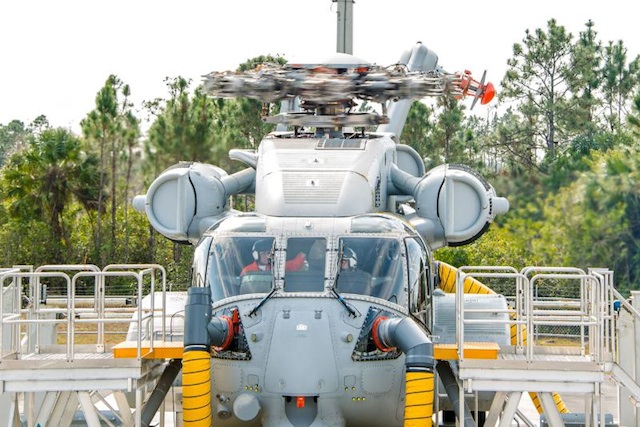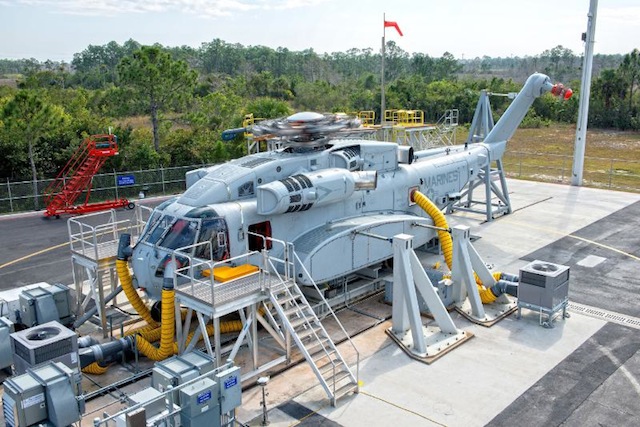Sikorsky is moving forward with ground testing of its prototype CH-53K heavy lift helicopter, announcing it has ignited the ground test vehicle’s 7,500shp-class General Electric GE38-1B engines and spun the rotor head.
The ignition, which occurred on 24 January, is part of the “bare-head light off” tests, which involve engine tests without the rotors attached to the rotor head.

Sikorsky's CH-53K ground test vehicle undergoes "bare-head light off" tests in West Palm beach in January 2014. Sikorsky.
Bare-head light off testing began in December with ignition of the ground test vehicle’s auxiliary power unit (APU).
Sikorsky’s vice president of the CH-53K programme Mike Torok calls the main engine ignition a “significant step” for the programme.
"Having independently tested the aircraft's many components and subsystems, including electrical and avionics, hydraulics and flight controls, landing gear, propulsion, transmissions and rotors, now we have begun testing these critical functions as an entire system powered by the... engines," he says.
Sikorsky says the 19,958kg (44,000lb) prototype is anchored to the ground at an outdoor test area at its facility near West Palm Beach in Florida.
The vehicle is fitted with sensors at more than 1,300 locations to help ensure it will operate safely under its own power, says Sikorsky.

The test vehicle, which will never fly, anchored to a stand at the company's facility near West Palm Beach, Florida. Sikorsky.
The ground-test vehicle will undergo tests for about two years by both Sikorsky and the US Marine Corps, the aircraft’s launch customer.
Following bare-head testing, Sikorsky will attach the seven main rotor blades and four tail rotors and begin further systems checks.
The aircraft must then pass a “formal pre-flight acceptance test” before the first flight test aircraft will be cleared to fly, says the company.
Sikorsky has four flight test aircraft under development and expects the first flight to occur late this year.
The flight test programme is expected to last three years, during which the ground test vehicle will undergo evaluation of the long-term endurance of its engines, dynamic components and survivability. The company will also study maintenance practices, Sikorsky says.
Developed for the Marine Corps, the CH-53Ks powered by three GE engines and will have a 39,900kg maximum gross weight, says Sikorsky.
The aircraft will be able to carry an external load of more than 12,200kg over a mission radius of 110nm (204km), triple the capacity of Sikorsky’s CH-53E Super Stallion, the company says.
The US Defense Department intends to purchase 200 of the aircraft, which are expected to reach initial operational capability in 2019, Sikorsky says.
The US Marine Corps intends to have eight active CH-53K squadrons, one training squadron and one reserve squadron, according to Sikorsky.
Low-rate initial production of the type will likely start in 2015 and continue until 2017, and full-rate production should start between 2019 and 2022, the Navy has told Flightglobal.
Source: FlightGlobal.com
















